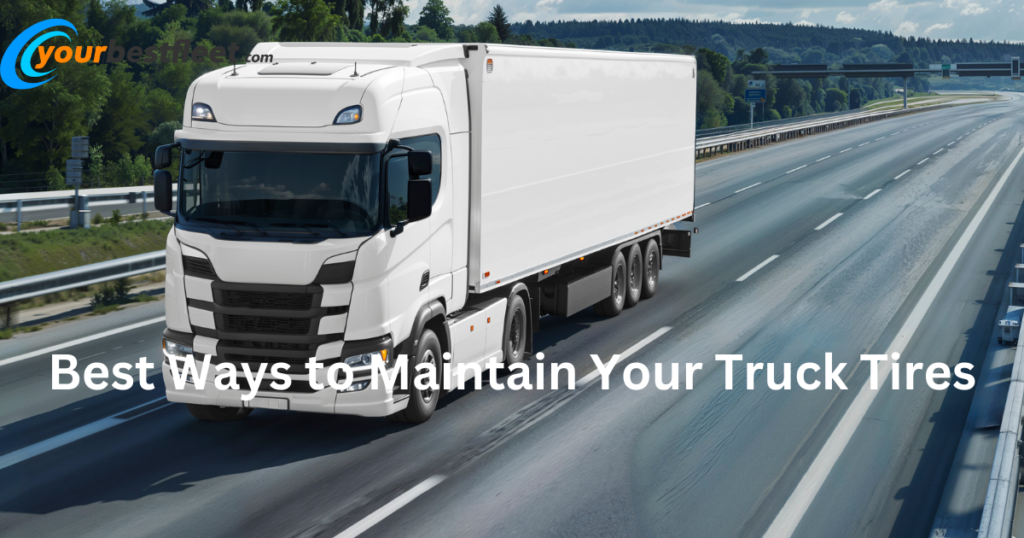Key Takeways
- Check tire pressure weekly and adjust to manufacturer specifications to prevent uneven wear and blowouts.
- Inspect tread depth regularly and replace tires below 4/32 inches for safe traction.
- Rotate tires every 5,000–8,000 miles to ensure even wear and extended lifespan.
- Balance and align wheels every 10,000 miles to prevent vibrations and handling issues.
- Avoid overloading, keep tires clean, monitor temperature on long trips, and invest in high-quality tires for durability.
Incorrect tire pressure leads to uneven wear, reduced fuel efficiency, and higher risks of blowouts. Underinflated tires increase rolling resistance, causing excessive heat buildup, while overinflated tires reduce traction and compromise stability.
Steps to Ensure Correct Tire Pressure:

- Check tire pressure weekly using a calibrated gauge to ensure it matches manufacturer specifications.
- Measure pressure when tires are cold (before driving) to get an accurate reading, as heat expands air and distorts measurements.
- Adjust pressure according to load—heavier loads require slightly higher PSI within recommended limits.
- Use a Tire Pressure Monitoring System (TPMS) to receive real-time pressure alerts, reducing the risk of unexpected deflation.
Ignoring tire pressure maintenance leads to premature wear, poor handling, and higher fuel consumption.
Inspect Tread Depth and Condition
Tire treads provide grip, stability, and traction. Worn-out treads increase stopping distances, reduce wet-weather performance, and heighten the risk of hydroplaning. Tread inspection ensures safety and compliance with legal standards.
How to Check Tread Depth and Wear:
- Use a tread depth gauge to measure depth—replace tires when the depth falls below 4/32 inches for front tires and 2/32 inches for rear tires (per DOT regulations).
- Perform the penny test by inserting a penny into the tread with Lincoln’s head facing down—if the head is visible, the tread is too worn.
- Inspect for irregular wear patterns, cracks, or bulges, as these indicate suspension issues, alignment problems, or internal tire damage.
- Check for embedded objects like nails, glass, or sharp debris that could cause slow leaks or sudden blowouts.
Regular tread checks prevent traction loss and improve braking efficiency, especially in wet or icy conditions.
Rotate Tires at the Right Intervals
Uneven wear occurs due to variations in weight distribution and driving conditions. Rotating tires evenly distributes wear, extending tire life and maintaining optimal handling.
Tire Rotation Guidelines:

- Rotate every 5,000–8,000 miles (or at every oil change) to balance wear between front and rear tires.
- Use the correct rotation pattern based on drive type:
- Front-wheel drive (FWD): Swap front tires to the back and cross the rear tires to the front.
- Rear-wheel drive (RWD): Swap rear tires to the front and cross the front tires to the back.
- All-wheel drive (AWD): Follow an X-pattern or consult the manufacturer’s recommendations.
- Inspect tires during rotation for alignment issues, uneven wear, or damage.
Proper rotation ensures even tread wear, reducing the need for premature replacements.
Balance Tires to Prevent Vibration and Uneven Wear
Tire imbalance causes vibrations, irregular wear, and steering instability. Balancing corrects weight distribution around the wheel assembly, ensuring a smooth ride. Furthermore, conducting thorough pre-trip inspections, including checking the tire pressure and examining the tread depth, ensures that potential issues can be identified and addressed promptly. Such proactive measures not only safeguard the driver but also ensure the longevity and consistent performance of the tires.
Signs That Your Tires Need Balancing:
- Vibrations in the steering wheel, seat, or floorboard while driving at high speeds.
- Uneven or scalloped tread wear on specific sections of the tire.
- Increased road noise and reduced fuel efficiency due to improper weight distribution.
How to Balance Tires Properly:
- Get tires balanced every 10,000 miles or whenever new tires are installed.
- Use dynamic balancing techniques with precision weights to fine-tune wheel balance.
- Check balance immediately after hitting potholes or curbs, as impacts can displace weight and cause uneven wear.
Balancing prevents unnecessary stress on the suspension and steering system, ensuring optimal ride comfort.
Align Wheels to Prevent Steering Issues and Uneven Wear
Wheel alignment ensures that tires make proper contact with the road. Misalignment leads to uneven tread wear, poor fuel economy, and handling difficulties.
How to Detect Misalignment:
- Vehicle pulls to one side even when driving straight.
- Uneven tread wear on the inner or outer edges of the tires.
- Steering wheel vibrates or feels off-center even when driving on a straight path.
Wheel Alignment Recommendations:
- Check alignment every 10,000 miles or after hitting potholes, curbs, or road debris.
- Ensure proper camber, caster, and toe angles are adjusted during professional alignment.
- Align wheels whenever new tires are installed to maximize tread life.
Proper alignment prevents excessive stress on suspension components, ensuring a smoother ride and longer-lasting tires.
Avoid Overloading to Reduce Tire Stress

Overloading a truck strains tires, leading to excessive wear, sidewall damage, and potential blowouts. Additionally, addressing any tire-related issues promptly is crucial before they escalate into more significant problems. Utilising technological solutions, such as ELD solutions that monitor driving habits and provide insights through driver scorecards, can aid in identifying and rectifying poor driving habits, thereby contributing to the preservation of tire integrity and overall vehicle safety.
How to Prevent Overloading:
- Check the Gross Vehicle Weight Rating (GVWR) on the truck’s placard to ensure weight limits are not exceeded.
- Distribute weight evenly to prevent excessive stress on specific tires.
- Use heavy-duty tires rated for higher load capacity when carrying frequent heavy loads.
Excess weight accelerates tire wear and reduces overall performance, increasing maintenance costs.
Keep Tires Clean and Protected from Environmental Damage
Tires degrade over time due to dirt, chemicals, UV exposure, and extreme temperatures.
Tire Cleaning and Protection Tips:
- Wash tires regularly using mild soap and water to remove debris, grease, and road salt.
- Apply UV protectants to prevent rubber cracking and sidewall drying.
- Store spare tires in a cool, dry place to avoid exposure to extreme heat or moisture.
Protecting tires from environmental damage extends their lifespan and ensures consistent performance.
Monitor Tire Temperature on Long Trips

Overheating is a major cause of tire failure, especially for long-haul truckers.
How to Prevent Tire Overheating:
- Use tire temperature sensors to monitor heat buildup during long drives.
- Take rest breaks to allow tires to cool down if traveling for extended periods.
- Avoid excessive braking and high-speed driving as these generate additional heat.
Temperature monitoring helps prevent unexpected tire failures on long journeys.
Use High-Quality Tires for Durability
Investing in premium truck tires ensures better traction, durability, and load-bearing capacity.
What to Consider When Choosing Tires:
- Reinforced sidewalls for heavy-duty applications.
- Tread patterns designed for specific road conditions (all-season, off-road, or highway).
- Manufacturer warranty and durability ratings to ensure long-term reliability.
High-quality tires reduce maintenance costs and improve safety.
Repair Punctures Correctly to Avoid Blowouts

Improperly repaired tires compromise structural integrity, increasing the risk of sudden failures.
How to Properly Repair Punctured Tires:
- Use a plug-and-patch combination rather than just a plug for a long-lasting fix.
- Never repair sidewall damage or large punctures—replace the tire instead.
- Check for slow leaks regularly to prevent further damage.
Timely repairs maintain tire integrity and prevent costly replacements..
FAQ
How often should truck tires be inspected?
Truck tires should be inspected before every trip and at least once a week for wear, pressure, and damage.
What is the ideal tire pressure for trucks?
The ideal pressure varies by load and tire type, but it should always match the manufacturer’s recommended PSI.
How can I extend the lifespan of my truck tires?
Regular rotation, proper inflation, alignment checks, and avoiding overloading help extend tire life.
Why is tire alignment important for trucks?
Proper alignment prevents uneven wear, improves handling, and increases fuel efficiency.
When should truck tires be replaced?
Truck tires should be replaced when tread depth falls below 4/32 of an inch or if there are signs of severe wear or damage.
James Johnson is a former truck driver who now works as a writer, specializing in the trucking industry. With over 15 years of experience on the road, James has a unique perspective on the challenges and opportunities faced by truck drivers and the trucking industry as a whole. His writing focuses on issues such as safety, regulation, and the latest industry trends. His work has been featured in several trucking publications and he has received recognition for his contributions to the industry. In his free time, James still enjoys being around trucks and often attends truck shows and other industry events.


